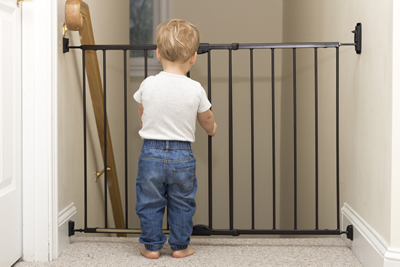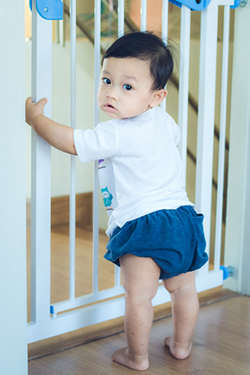Safety gates

Learn how to choose a safety gate for your child, and how to properly install and use it.
On this page
Choosing a safety gate
Safety gates are intended for use with children from 6 months through 24 months of age.
You should choose a gate that's meant for the area in which it will be used, such as:
- a hallway
- a doorway
- at the top or bottom of stairs
Most hospital visits involving safety gates are from children falling down stairs. Certain gates, such as some pressure-mounted gates, are not designed to be used near stairs. Prevent falls by finding out where your gate can be used. This information and other warnings are in the manufacturer's installation instructions.
Avoid using gates with holes that are large enough to be used as toe holds, as they can be used by children to climb over the gate. Openings in the gate should be small enough that a child's head or body cannot fit through.
Do not purchase gates that have diamond-shaped or V-shaped openings larger than 38 mm (1 ½ in) along the top and/or sides.
Safety gates come in various:
- designs
- configurations
- material construction
Any safety gate that's intended to prevent the passage of young children is subject to the Expansion Gates and Expandable Enclosures Regulations.
Gates that are designed and marketed solely for pets should not be used as a safety gate for children. They are not subject to the same regulatory requirements and are not intended to protect children.
Some gates manufactured before 1990 should not be used, as they:
- may have:
- wide v-shaped openings along the top
- large diamond shaped openings along the sides
- openings large enough to allow a child's head to fit through
- pose safety risks
- do not meet current regulatory requirements
Installing and using a safety gate

Always follow the manufacturer's instructions when installing a safety gate. Safety gates must come with manufacturer's instructions and should be labelled with age restrictions.
Make sure the gate is securely latched or locked in place each time it's closed. The locking mechanism should be on the side away from your child.
Every exposed part must be smoothly finished, whether it's made of:
- metal
- plastic
- wood
Ensure surfaces are free of:
- cracks
- splinters
- sharp edges
- other defects
- burrs (a raised sharp point that can cause a cut)